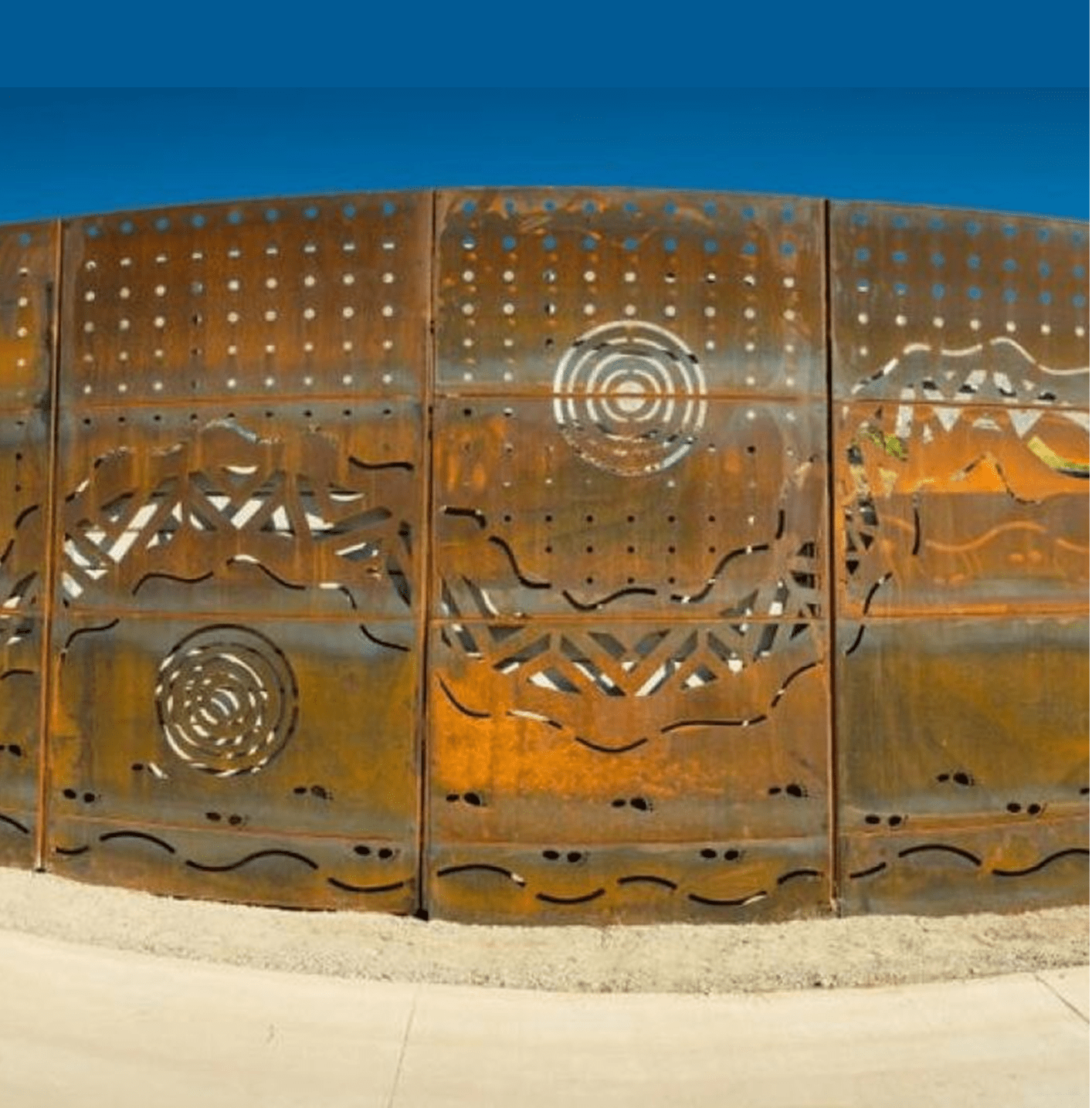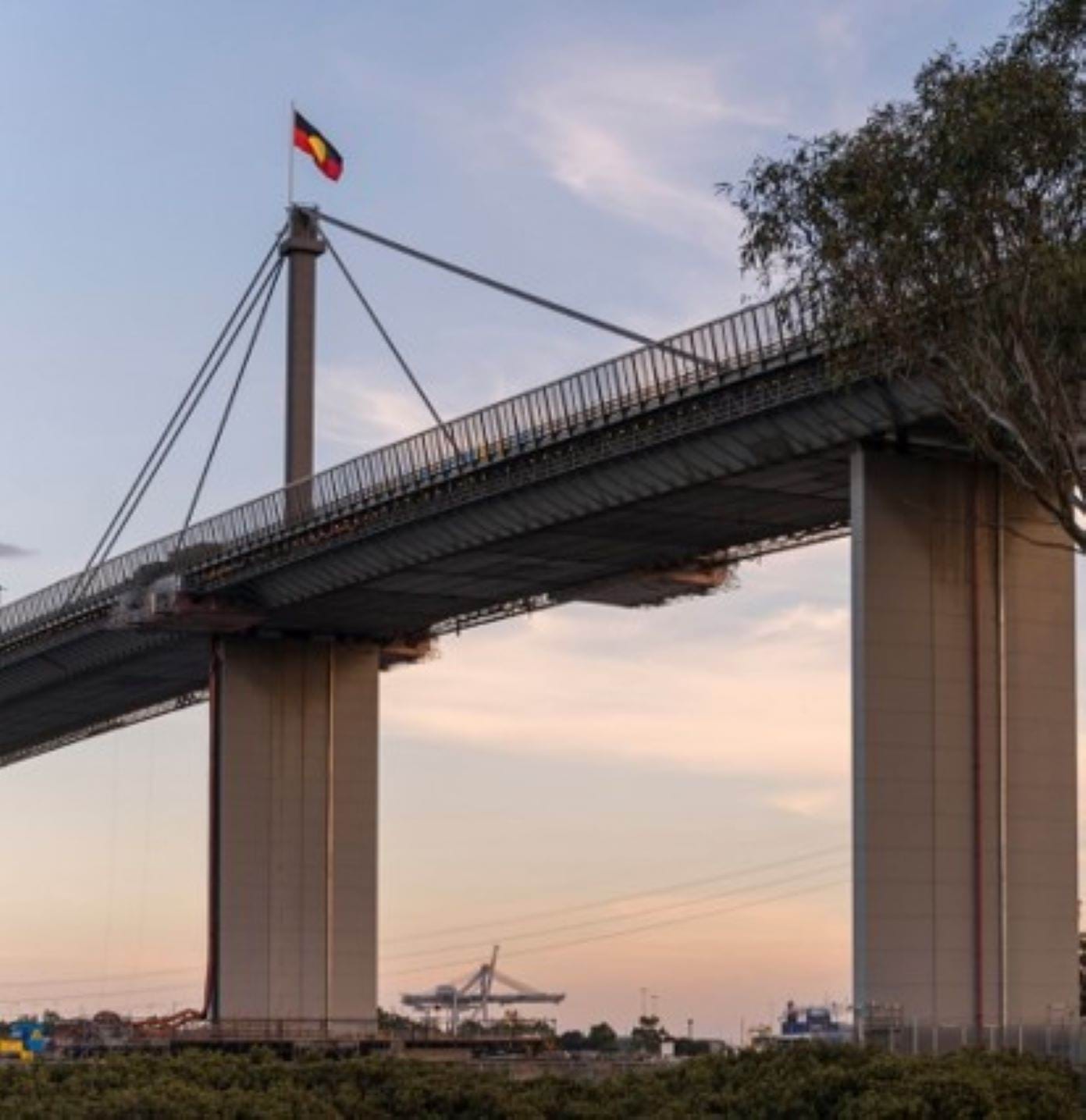- Published by:
- Department of Transport and Planning
- Date:
- 6 June 2025
Introduction
Wurrek-al ‘Talking with Purpose’ First Peoples Engagement Framework sets out the Transport and Planning Portfolio’s expectations when engaging with Traditional Owners and the First Peoples Community. Wurrek-al aims to equip staff with the necessary skills to engage effectively and meaningfully with Traditional Owners and the First Peoples Community. It will provide them with an understanding of:
- the eight fundamental principles of engagement,
- engagement process; and
- best practice engagement case studies.
The Framework is informed by:
- Victorian Aboriginal Affairs Framework 2018-2023(opens in a new window)
- Self Determination and Reform Framework(opens in a new window)
- United Nations Declaration on the Rights of Indigenous Peoples(opens in a new window)
- The Charter of Human Rights and Responsibilities Act 2006(opens in a new window)
- (opens in a new window)Transport Portfolio Aboriginal Self Determination Plan 2020-2023
- Traditional Owner Settlement Act 2010 (Vic)(opens in a new window)
- Native Title Act 1993 (Cth)(opens in a new window)
- Aboriginal Heritage Act 2006 (Vic)(opens in a new window)
- Yoorrook Justice Commission and our commitment to supporting truth telling(opens in a new window)
- Treaty in Victoria(opens in a new window)
Definition of Terms
First Peoples
- Refers to all people of Australian Aboriginal and/or Torres Strait Islander descent, living or visiting Victoria.
Traditional Owners
- Refers to the original custodians of Victoria who share a deep cultural, spiritual, and social connection with Country. They have unique rights and responsibilities in Caring for Country. Each Traditional Owner Group has their own unique culture, history, language, customs and laws.
First Peoples Community
- Refers to the wider community Aboriginal and Torres Strait Islander Community, including Traditional Owners. The First Peoples Community’s voice can be conveyed individually or through many First Peoples organisations and peak bodies. i.e. Aboriginal Community Controlled Organisations (ACCOs), Local Aboriginal Networks (LANs) and Gathering Places.
Commitment to self determination
The Transport and Planning Portfolio's commitment to self determination
The transport and planning portfolio (the portfolio) is committed to building and maintaining meaningful partnerships with Traditional Owners and the First Peoples Community. The portfolio is committed to embedding First Peoples self determination through its Transport Portfolio Aboriginal Self-Determination Plan 2020-2023 (Plan).
The Plan outlines how the portfolio will transform its systems and processes to enable Traditional Owners and First Peoples communities to realise their aspirations for transport.
The Plan incorporates 11 key actions that respond to the overarching commitments set out in the Victorian Aboriginal Affairs Framework 2018-2023 (VAAF) and covers the four Self Determination Reform Framework (SRDF) domains which are People, Systems, Outcomes and Accountability.
The First Peoples Self Determination and Reform Division (FPSDR) has a key responsibility to advise and facilitate self determination reform across transport and planning and the delivery of the 11 actions that underpin the Plan.
FPSDR provides leadership, culturally sound advice, and strategic direction to guide and empower staff to genuinely partner and meaningfully engage with Traditional Owners and the First Peoples Community across the portfolio.
Engagement Specialists
Portfolios Engagement specialist
Engagement Specialists
First Peoples Partnerships and Engagement
The First Peoples Partnerships and Engagement team (P&E) is the first point of contact for advice on engaging with Traditional Owners and First Peoples Community. The P&E team sits within FPSDR and operates alongside the Careers and Cultural Safety and Policy and Reform teams.
P&E can be contacted via email at firstpeoples.engagement@ transport.vic.gov.au
Aboriginal Partnership Officers
P&E may choose to facilitate the engagement process through Aboriginal Partnerships Officers (APOs). APOs sit under Transport Services and are located within each transport and planning region.
APOs are responsible for leading, coordinating and providing expert advice to develop, maintain and support strong working local partnerships with:
- local Registered Aboriginal Parties,
- Aboriginal Community Controlled Organisations and;
- other First Peoples Community groups within the region
Traditional Owners and Formal Recognition
Traditional Ownersand Formal Recognition
In Victoria, approximately 75% of the state is formally recognised, whereas the other 25% does not yet have formal recognition status. There are 3 ways in which the Victorian Government formally recognises Traditional Owners of a particular Country:
- by way of the Victorian Aboriginal Heritage Council appointing a Traditional Owner corporation as a Registered Aboriginal Party under the Aboriginal Heritage Act 2006 (Vic)
- by way of a recognition and settlement agreement under the Traditional Owner Settlement Act 2010 (Vic)
- by way of a consent determination by the Federal Court under the Native Title Act 1993 (Cth) and accompanying Indigenous Land Use Agreements.
The Heritage Practice branch is comprised of qualified Heritage Advisors and sits within Strategy & Precincts, DTP. The Heritage Practice branch provides technical support on how best to apply these Acts at the project level and work closely with FPSDR on this aspect of engagement. This includes understanding compliance triggers, approval pathways and engaging with Traditional Owners on:
- Cultural Heritage Management Plans,
- Cultural Permits and;
- Cultural Values Assessments.
Principles of Engagement
How to partner and engage with Traditional Owners and the First Peoples Community
It is an expectation that portfolio staff and contractors are culturally safe and engagement ready. The following eight principles have been developed in partnership with Traditional Owners and the First Peoples Community and provide guidance on how to best engage with Traditional Owners and the First Peoples Community.
Process of Engagement
Step by step Process of Engagement
The below is an overview of the steps in the engagement process. P&E will partner and support you throughout the engagement process. Promapp is Wurrek-al’s implementation tool and contains further information and resources for each step.
- Prepare and Plan
Complete First Peoples Engagement template
- Contact First Peoples Partnerships and Engagement
- Engage
Apply engagement principles and P&E advice
- Evaluate Engagement
Complete First Peoples Engagement Evaluation Form
- Keep Informed of Project Outcomes & Successes
Share project successes and outcomes with Traditional Owners and/or First Peoples Community
Step by step Process of Engagement:
Case Study
Turning Words into Actions – Dhungala Bridge Project
“ Engage early, seek mutual understanding and push for local opportunities”
- Aunty Judy Atkinson, Yorta Yorta Elder
In 2022, in partnership with Yorta Yorta Nation Aboriginal Corporation (YYNAC), Major Road Projects Victoria (MRPV) and Transport for NSW built a second Murray River (Dhungala) crossing to connect Echuca and Moama. The project involved several decades of planning with YYNAC being involved from the outset.
MRPV required a minimum 2.5% Aboriginal employment target (AET) based on actual hours worked as well as a minimum social procurement target of 3% of the contract value. As project partners and a matter of cultural respect, YYNAC were prioritised to have meaningful input in contributing to the AET and to improving employment outcomes for their community.
MRPV and it’s construction partner McConnell Dowell Constructors (MCD) engaged with YYNAC prior to construction to gain insights into effective ways to engage with local Aboriginal job seekers and better understand the types of works best aligned to the capability, capacity and business aspirations of local Aboriginal-owned businesses.
As a result of the early and ongoing engagement with YYNAC, Aboriginal employment had greatly exceeded the 2.5% AET, peaking at 7.3% of the workforce during the Project. The Project spent $3.45m (2% of the total contract value) with Aboriginal businesses.
This included the engagement of local Aboriginal business AKO Earth, a civil earthworks business; Zancott Recruitment, who provided labour hire support for the project; Woka Walla Natural Resource Management (YYNAC land management team) to undertake weed control; as well as the direct employment of two full-time Aboriginal employees.
Furthermore, the project made it a key priority to highlight and preserve Yorta Yorta’s rich cultural connection to the land around the Murray and Campaspe rivers by naming the bridge’ Dhungala’ the Yorta Yorta word for Murray River and through the installation of Dhungala Dreaming at Victoria Park. Dhungala Dreaming was designed by local Yorta Yorta elder, Aunty Judy Atkinson and serves as a lasting reminder of the projects very successful collaboration with the Yorta Yorta People.
Case Study
Best Practice Engagement across the portfolio. Aboriginal Flag flying permanently on the West Gate Bridge.
The then, Department of Transport, Minister of Roads and Road Safety Ben Carroll and Minister for Treaty and First Peoples Gabrielle Williams, at the end of NAIDOC Week 2022 announced the Aboriginal Flag will be flown on the West Gate Bridge permanently alongside the Australian Flag.
Since 2019, the Aboriginal and Torres Strait Islander flags were flown on rotation atop the West Gate Bridge only during Reconciliation and NAIDOC Weeks. The flags represent a symbol of unity, identity and resilience used proudly by many Aboriginal and Torres Strait Islander people across Australia.
In June 2022, the Department worked closely with the First People’s Assembly of Victoria, the Minister of Treaty and First Peoples, Gabrielle Williams and Registered Aboriginal Party Bunurong Land Council Aboriginal Corporation on whose Country the West Gate Bridge is located, all support the permanent installation of the Aboriginal Flag in preparation of the Aboriginal Flag permanent raising of the flag during NAIDOC week.
The installation of additional flagpoles will form part of future investigations which will ensure that the bridge remains structurally safe.
Flying the Aboriginal Flag permanently demonstrates Victoria’s commitment to Aboriginal self-determination and acknowledges and celebrates Aboriginal and Torres Strait Islander people, history, heritage and culture. Now a permanent fixture in the Victorian skyline.
Commitment to Culturally Safe Engagement
Together, we will ‘talk with purpose’
Wurrek-al informs the portfolio’s process involved when engaging with Traditional Owners and the First Peoples Community throughout Victoria. It aligns with the portfolio’s and the Victorian Government’s commitment to self determination, enabling Free, Prior and Informed Consent (FPIC), greater visibility and decision-making for Traditional Owners and First Peoples Community regarding transport and planning projects that impact them.
The structure and process outlined in Wurrek-al is underpinned by FPIC principles – a specified right granted to Indigenous Peoples in the United Nations Declaration on the Rights of Indigenous Peoples. Wurrek-al reflects First Peoples values around culturally safe engagement, reflecting and understanding that context will determine when engagement is undertaken and at what level; how it will be undertaken and with whom.
Wurrek-al will be administered by the Department of Transport and Planning and regularly reviewed to meet the changing needs of Traditional Owners and the First Peoples Community of Victoria.


